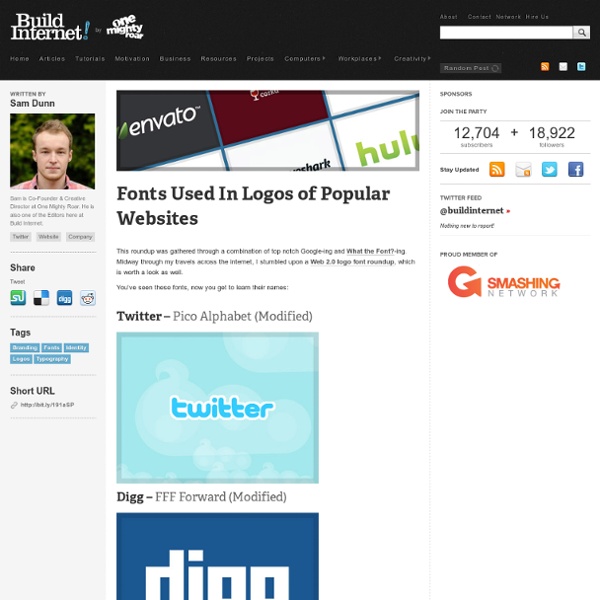Famous Fonts - Fonts you recognize, FREE for download! - famousf
Circle Hover Effects with CSS Transitions
« Previous Demo: Animated Responsive Image Grid Back to the Codrops Article Use what you have by Angela Duncan View on Dribbble Common Causes of Stains by Antonio F. Mondragon View on Dribbble Pink Lightning by Charlie Wagers View on Dribbble
09. Type and colour
AUTHOR’S NOTE – You’re reading the HTML version of a chapter from the book Building Accessible Websites (ISBN 0-7357-1150-X). Copyright © Joe Clark, 2002 (about the author). All rights reserved. ¶ Back to Contents Reading is the primary activity of the Web. For people with impaired vision who do not use screen readers, colour choices and, to a far lesser extent, type size become the accessibility issues. The big surprise is how little work you must do to provide for big type on your Websites (in fact, no work at all for the group that truly is visually-impaired). In this chapter: We’ll learn about the anatomy of colourblindness. As we are all too aware, a perennial objection to making Websites accessible comes in the form of a reflexive bleating from Web designers per se: “What, I can’t use graphics? Um, no. However, colours used elsewhere on your site must be selected with modest care. The central problem I will not pass judgement on these æsthetic lapses. What is colourblindness? Anatomy
100+ Seamless Patterns Great for Creating Website Backgrounds
1026 shares 200+ Seamless Patterns Perfect for Website Backgrounds We’re always on the lookout for great freebies to share with our readers, and today we’ve got some seamless patterns. Seamless patterns are a great way to add a lot of detail to a design and fill up a big area, such as a background. Here are over 200 patterns that are perfect for creating… Read More 46 shares Best Places to Find Seamless Background Patterns Web Designers are always in need of background patterns.
Las mejores 32 herramientas tipográficas de la web - elWebmaster
En este útil artículo les brindaremos todo tipo de información acerca de útiles herramientas que los pueden ayudar a trabajar con las tipografías de sus sitios web. Hay herramientas para que creen sus propias fuentes, para que encuentren fuentes que necesitan o desean, herramientas siFR y recursos, algunos plugins Firefox y varios relacionados con CSS. ¿Qué esperas para conocerlos? 1.TypeTester Typetester es una aplicación online para comparar las fuentes en la pantalla. 2.IdentiFont Identifont es el mayor directorio de typefaces de Internet. Encontrar fuentes por aparienciaEncontrar fuentes por nombreEncontrar fuentes por similitudEncontrar fuentes de símbolos e imágenesEncontrar diseñadores y publicadores 3.WhatTheFont (MyFonts) Podrás subir una imagen de una fuente que viste y no sabes cuál es para encontrar la que más se parece dentro de la base de datos del sitio. 4. 5. 6. Una gran cantidad de fuentes geniales para tu hoja de estilos CSS, puedes bajarlas todas en este documento pdf. 7.
HTML5 video and audio tags in all major browsers
dafont.com
Playtype | Typographer's Glossary
Serif: Serif's are semi-structural details on the ends of some of the strokes that make up letters and symbols. A typeface that has serifs is called a serif typeface (or seriffed typeface). Some of the main classifications of Serif type are: Blackletter, Venetian, Garalde, Modern, Slab Serif, Transitional, and Informal. Fonts in each classfication share certain similiar characteristics including the shape or appearance of their serifs.
A 3D Flocking Simulation using HTML5 Canvas
I recently unearthed an old Java applet that I had written many years ago and decided to see what it would look like as a single page canvas application (an HTML5 compatible browser is required to view this page). The applet was inspired by the way blackbirds roost on power lines in San Francisco (and probably everywhere else). I started with something close to Craig Reynold’s classic Boids algorithm, which is remarkable for generating motion resembling a flock of birds by giving each particle only 3 relatively simple mathematical constraints. I had to add 6 more rules to incorporate the power line behavior (2 for landing, 1 for hopping on the line, and 3 for launching off the line). The rules are: Since the application is only required to draw simple circles and lines, there was little opportunity to explore features of the canvas API. Feel free to view the source and use what you like. Alex is Carbon Five's resident mad genius.
CSS Gallery Web Design Gallery For Inspiration
15+ techniques and tools for cross browser CSS coding
Part 1 – Techniques Of course, efficient crossbrowser CSS development starts with techniques and good practices. In the first part of the article, I’ll show you X techniques that will make your crossbrowser development easier. Reset CSS Due to the fact web browsers define different default styling for html elements, the first thing to do is to always include a CSS reset in your stylesheet. Internet Explorer conditionnal comments Let’s face it: Internet Explorer, especially the dinosaur IE6, is the front-end developer nightmare. You can also target only a certain version of IE: Internet Explorer hacks While conditionnal comments are better, you can also target some versions of Internet Explorer using the following syntax: This technique is not W3C compliant (this is why you should use conditionnal comments instead) but sometimes, it is a real time saver. Targeting Opera only Opera isn’t the popular browser, but that isn’t a reason not fix problem that may occur. Targeting Safari only Get the code



